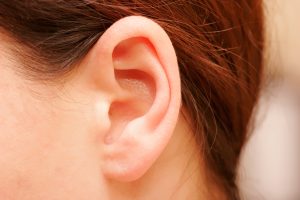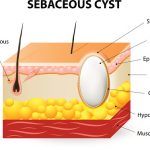 Painless lump behind ear is a condition that is not uncommon, and while some lumps require little to no attention, others may need medical treatment.
Painless lump behind ear is a condition that is not uncommon, and while some lumps require little to no attention, others may need medical treatment.
A painless lump behind the ear can be big or small in size, and it can go unnoticed for days or weeks. Essentially, it is an area of swelling that can take place anywhere on the ear. Some people may refer to it as a bump, nodule, tumor, or cyst. Depending on what the cause of the lump behind the ear is, it can be soft or firm. Some people even get multiple painless lumps behind the ear.
Advertisement
Whether a person has a painless lump behind ear lobe or a painless lump behind ear on bone, it can grow quickly. In some cases, it starts out very small and stays that way. Infections, tumors, inflammation, or some sort of trauma can cause painless lump behind the ear.
Painless lumps behind ear: Sebaceous cysts
Some lump behind ear sites are more common than others. For example, the ear canal, ear lobe, and behind the ear are not unusual places to find such a lump. Many people find that a sebaceous cyst doesn’t need any treatment, but others discover that if the lump rubs up against other body parts or clothing, causing it to break and get infected, it requires attention. In certain situations, people decide to have the cyst surgically removed.
Sebaceous cysts are basically dead skin cells and oil produced by oil glands. These cysts are common behind the ear lobe. However, they can also be found in the ear canal. Some people get recurring sebaceous cysts. It is thought that these individuals might just have skin glands that produce oil faster than they can be released from the gland.
Sebaceous cysts symptoms and causes
 To understand how sebaceous cysts form, we have to look at the surface of our skin. Dermatologists know that the epidermis, which is the outer layer of cells that make up our skin, are always shedding. They suspect that cysts develop when these cells move deeper in the skin and multiply, as opposed to shedding. These cells are what forms the walls of the cyst.
To understand how sebaceous cysts form, we have to look at the surface of our skin. Dermatologists know that the epidermis, which is the outer layer of cells that make up our skin, are always shedding. They suspect that cysts develop when these cells move deeper in the skin and multiply, as opposed to shedding. These cells are what forms the walls of the cyst.
The inside of a cyst is made of keratin. This is a protein, which sometimes will drain from a cyst. It looks thick and yellow. Medical scientists suggest that the cell growth is caused by a damaged hair follicle from the oil gland in the skin.
Sometimes, people mistake an epidermis cyst with a sebaceous cyst. Skin experts say they are actually two different types of cysts.
Those who have a sebaceous cyst might experience the following symptoms:
- A small, round lump under the skin
- Redness, swelling
- Tenderness
- Inflammation
- Infection
- A tiny blackhead plugging the central opening of the cyst
- Thick, yellow, smelly substance draining from the cyst
If a person notices extreme swelling, infection, or rapid growth of the cyst, immediate medical attention should be sought.
Sebaceous cyst treatment
If a cyst is not bothering you, the best approach is to simply leave it alone. In cases where the cyst is annoying, inflamed, or infected, treatment is available. Doctors have a number of options when it comes to addressing sebaceous cysts. They can inject the cyst with a medication to help reduce swelling and inflammation. They can drain the cyst, which is a fairly quick procedure. Or, they can remove the cyst completely through a minor surgical procedure. In recent years, some doctors have turned to lasers to vaporize cysts.
Painless lumps behind ear: Lipoma
 One painless lump behind ear type is called lipoma. This is a relatively harmless deposit of fat under the skin. It can also be found on the neck, back, shoulders, arms and thighs, but normally it is a soft painless lump behind the ear that is due to the development of fatty tissue that grows slowly under the skin. While people can get lipoma at any age, it is rare for children to develop this kind of lump. Most people aren’t bothered by lipoma, but a dermatologist can remove it if a patient finds it bothersome.
One painless lump behind ear type is called lipoma. This is a relatively harmless deposit of fat under the skin. It can also be found on the neck, back, shoulders, arms and thighs, but normally it is a soft painless lump behind the ear that is due to the development of fatty tissue that grows slowly under the skin. While people can get lipoma at any age, it is rare for children to develop this kind of lump. Most people aren’t bothered by lipoma, but a dermatologist can remove it if a patient finds it bothersome.
Lipoma is considered a benign growth. In other words, it is not cancerous so people need not panic if they discover one.
Lipoma symptoms and causes
It is thought that lipoma is inherited, but more research is required to gain a better understanding of how these types of lumps develop. Some experts also believe that a minor injury or being overweight could cause the growth of lipoma.
If a person has lipoma, they might notice the following:
- Small, lump 0.4 inch (one cm) to 1.2 inch (three cm) just under the skin
- Moveable, soft, rubbery feeling
- Lump that remains the same size for a very long time
Lipoma treatment
 When a doctor attempts to treat lipoma, they take a number of factors into consideration first, including the size of the lump, the number of skin tumors, history of skin cancer, family history, and whether or not the patient is experiencing any pain.
When a doctor attempts to treat lipoma, they take a number of factors into consideration first, including the size of the lump, the number of skin tumors, history of skin cancer, family history, and whether or not the patient is experiencing any pain.
The most common form of treatment for lipoma is through surgery. This is usually helpful in situations where the growth is large. Liposuction is another treatment. Lipomas are fat-based, so liposuction can work to reduce the size of the lump. It’s a procedure that involves a needle attached to a large syringe. The area that the doctor is working on is numbed before the procedure is carried out. Steroid injections have also been used to shrink lipoma, but it does not completely remove it.
Painless lumps behind ear: Benign tumors
Benign tumors sound scary, but they are, in fact, noncancerous growths. They do not spread to other parts of the body, like cancerous tumors can. They can develop on any part of the human body. People who find a lump on their body often assume it is cancer. For example, women who find a lump in their breast during self-examination can become worried. The truth is, most breast growths turn out to be benign. Many growths on the body are benign, including painless lump behind the ear.
Benign tumors symptoms and causes
Benign tumors tend to develop when cells in the body divide and grow at a very rapid rate. Normally, the body is able to balance cell growth and division. There are times when old cells remain on or in the body instead of dying, and that’s when they can grow into tumors.
Not all tumors are accompanied by symptoms. In many cases, it depends on where the growth is. For example, if a person has a brain tumor, they could experience dizziness, headaches, or memory problems.
Here are some possible symptoms of a benign tumor:
- Chills
- Fatigue
- Fever
- Loss of appetite
- Night sweats
- Weight loss
- Discomfort or pain
Benign tumors treatment
Advertisement
When a tumor is benign and small, doctors often suggest watching and waiting to see what happens with it, as opposed to treating it right away. It is believed that treating some benign growths can cause more harm than good. Treatment options normally depend on the location of the benign tumor. Tumors that impact organs, nerves, or blood vessels can be addressed with surgery to prevent further medical problems.
Thanks to modern medicine, tumor surgery can often be conducted using an endoscopic technique. This means the instruments are in a tube-like form and the surgery requires only small surgical incisions that do not take a long time to heal. Some people call this less invasive surgery. When surgery isn’t an option, doctors might suggest radiation therapy to reduce the size of the tumor or to prevent it from getting any bigger.
Whether it is a hard painless lump behind ear or a soft painless lump behind ear that you are experiencing, if you have the condition for more than four weeks, it is a good idea to have it checked out by a doctor. In the majority of cases, the lump or nodule will be nothing to be concerned about and a quick visit to the doctor will give you peace of mind. If there is inflammation or infection, or if you want to have the lump removed simply for cosmetic reasons, take comfort in knowing that there are options available.
